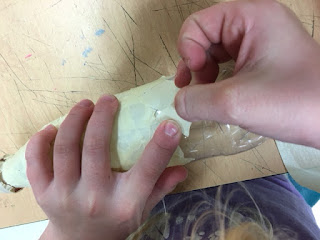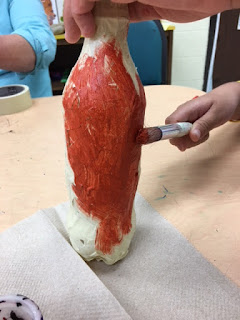
When I asked elementary students at the beginning of the year what kind of things they wanted to make, the most common answer was, "Fidget Spinners!" Long before the current toy sensation, though there were other kinds of spinners, toys like tops yo-yos, and and whirligigs, so I decided to do a history lesson that included the original Fidget Spinner, as part of our color theory unit.
I began by talking about pioneers crossing the country in their covered wagons or handcarts. Can you imagine moving and having to fit all of your family's possessions in to one car? What if you could only take one thing, what would it be? I shared my childhood road trip game: If I Were Going Across the Plains" We went around the class, and each person filled in the blank, "If I were going across the plains, I would take a......" I explain that the word they chose is a direct object. The first person then tells what they would do with their object. "I would eat my food." Then we we go around the group with each person using the same verb as the first person, but keeping their original direct object. "I would eat my hat....I would eat my book.....I would eat my sleeping bag" The second person then chooses the verb that makes sense for their object, "I would put my hat on my head." and continues, "I would put my book on my head...." This lead into a discussion about how few toys would be allowed to travel, and what kind of toys the pioneer children actually had.

The type of whirligig, that pioneers used, is a small, wooden disc with two holes on either side of the center point. and a piece of twine. This is threaded through both holes like a button and tied together at the other end. By holding the ends of the twine loop in two hands and moving the hands in small circles like you would jumping rope, the twine becomes twisted to the point that the hands move closer to the disc. Once the hands are slowly pulled apart, the disc spins and as the hands relax, the disc winds itself up in the opposite direction. So by pulling and relaxing, the whirligig can spin for minutes, or until the string starts cutting off the circulation in your fingers. I used a role of masking tape as a template to trace the circles--wood is much easier to spin, but a couple cardboard circles hot-glued together can work too. The holes are about a thumbs width apart and the string should be about a yard long (18" after it's folded it in half).
Since we've been studying the primary colors (red, yellow, and blue), and the fact that two primaries mixed together make a secondary (orange, green, purple), the students were to pick to primaries for each side of their whirligig. They could do spirals, dots, stripes, star bursts etc. as long as the colors remained separated but close together. The two primary colors visually mix into a secondary color once the whirligig gets spinning. Playing my childhood game, sharing my pioneer ancestor stories, painting, and spinning whirligigs--there are days my job is so enjoyable that I can hardly believe I get paid.
 String buttons, beads or bells on wire; close the circle, add a bow, and you've got yourself a wreath ornament for the Christmas tree. It's the holiday craft that even small children can do.
String buttons, beads or bells on wire; close the circle, add a bow, and you've got yourself a wreath ornament for the Christmas tree. It's the holiday craft that even small children can do.












